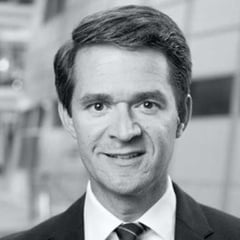

Crosschq Blog
Q&A with Thought Leader Brooks Holtom, PhD

Welcome Brooks Holtom, PhD
Crosschq is excited to announce Brooks Holtom, PhD, expert and leading researcher in the fields of organizational behavior and human resources, as our Chief Science Advisor.
December 3, 2019
SAN FRANCISCO, December 3, 2019 – Brooks Holtom, Senior Associate Dean and Professor of Management at the Robert Emmett McDonough School of Business at Georgetown University, is joining Crosschq, the industry leader in Human Intelligence HiringTM, as Chief Science Advisor. In this role, he will help guide the Crosschq data science team in the development of various predictive models to better match job candidates, roles, and companies.

Professor Holtom’s research focuses on how organizations acquire, develop, and retain human and social capital. His research appears in the top journals in management such as Academy of Management Journal, Journal of Applied Psychology, and International Journal of Human Resource Management, and also has high impact.
He’s received the Human Resource Management Scholarly Achievement Award in 2013 from the Academy of Management and has twice received the Professor of the Year award for the Georgetown University Executive Masters of Leadership Program. He has performed research in or served as a consultant to many organizations including Bayer, Booz Allen Hamilton, Capital One, Citibank, International Monetary Fund, KPMG, Microsoft, Nordstrom, Rio Tinto, Rolls Royce, Sprint, United States Air Force, U.S. Chamber of Commerce, and the World Bank.
Professor Holtom was kind enough to sit down with the Crosschq team and give us his thoughts on our upcoming partnership.
Q: Can you tell us a little bit about yourself; what do you do and how did you get here?
A: I started my professional life as a CPA in a large public accounting firm… but found the questions that most interested me most were about the people in the firm, not the tax code. So, I was determined to get a PhD and study why people leave organizations. The top scholars in the field were at the University of Washington and I was fortunate to work with Dr. Terry Mitchell and Dr. Tom Lee there.
Fast forward, I am a Professor of Management at Georgetown University where I have taught undergraduate and graduate students for 18 years. Along the way I have been fortunate to receive a number of awards for my research and teaching.
Q: You have a reputation as one of the most quantitative professors in management education. Where does that come from?
A: While I have repented of being an accountant, I cannot fully divorce myself from critical concepts like return on investment. In other words, serious leaders count both the cost and the benefit of investments in people. For most organizations, payroll is the first or second largest expense. Therefore, it is critical to manage this resource well.
Q: You are one of the world’s most cited authors on employee turnover. How did you get involved so deeply in this area?
A: When I was an accountant, I saw half of my colleagues leave over the course of two years…and then I left. This started my interest in the topic. In my dissertation I developed a concept called Job Embeddedness—a theory of why people stay at a firm. Since then research has been conducted on every inhabited continent testing the theory and finding that while there are some subtle differences across cultures, in general there is a predictable pattern in the factors why people remain at a company.
Q: What are some of the biggest issues employers face as it relates to hiring and employee turnover?
A: The best organizations know who their best people are and do all they can to keep them. They ask them for referrals because top performers frequently have friends who are also high performers (aka, birds of a feather flock together…). These firms understand the power of social networks and leverage them to acquire and retain talent.
In contrast, many organizations struggle to identify and keep their best people. They can recite their overall turnover rate but can’t tell you with confidence if they lost above average or below average people.
Q: In your previous research, what indicators of long employee tenure and high-performance have you uncovered?
A: We have found that people who are embedded in their organizations and communities are most likely to stay. Becoming embedded is a function of three elements. First, embedded people have strong fit with the values of the company and demands of the job. Second, embedded people have strong links to others in the organization such as mentors, coworkers and teams. Third, people feel more embedded when they would have to make significant sacrifices if they left the organization. For example, employer provided childcare is a particularly “sticky” benefit because leaving the employer entails disrupting at least two social networks.
Q: Are there any tips you may have for companies looking to turn around a negative turnover trend?
A: Contrary to what some consultancies will tell you, turnover rarely has a single cause. The reasons why employees leave are varied and generally complex. Because changing organizations involves many professional and personal factors, most people are very thoughtful about the process. Thus, my top tip for companies looking to improve employee retention is to collect and carefully analyze high-quality data. For example, there are nine dimensions of job satisfaction. Knowing which dimensions employees are most happy with and those that they are least happy with may be instructive. Moreover, knowing which dimensions matter most to your top performers allows an organization to make strategic investments in activities or programs that address the core underlying issues that should move the needle on retention.
Q: Last question… What excites you the most about partnering with Crosschq?
A: We live in an exciting era when we have access to amazing amounts of data that can be used by the most thoughtful organizations to increase their odds of hiring well. Because hiring and retaining talented employees is so central to organizational success, firms that are a step ahead of their competitors are likely to develop a significant and sustainable advantage.
I have spent the past twenty years studying the reasons why people leave organizations and the reasons why they stay. Interestingly, the reasons overlap but are not mirror opposites. Thus, if the goal for companies is to keep good people, they should be investing in the front end of the hiring process…not doing exit interviews on the way out when it is too late. I look forward to partnering with Crosschq to develop a world-class capability for sourcing talent.
Thank you Professor Holtom! We at Crosschq are excited to begin our partnership and help companies across all industries, and most importantly, the talented candidates applying for new jobs, find the right match and start hiring better now.
Take the Guesswork
Out of Hiring
Schedule a demo now



%20-200x43.png)





